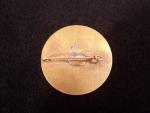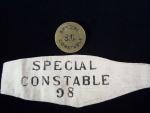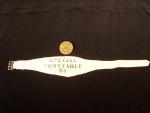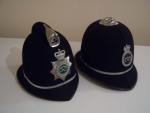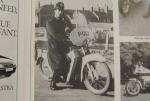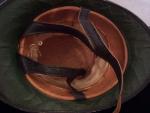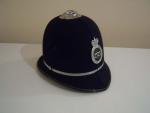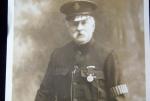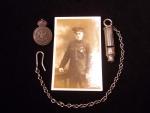-
Posts
6,486 -
Joined
-
Last visited
-
Days Won
10
Content Type
Profiles
Forums
Blogs
Gallery
Events
Store
Everything posted by Brian Wolfe
-

WORLD FLAGS PRE- 1914
Brian Wolfe replied to Mervyn Mitton's topic in Great Britain: Research, Documentation & History
Hi Mervyn, I always like to see pictures of these older flag groupings, especially with the original Canadian flag. I have one of the old originals tucked away for future generations. Regards Brian -

WORLD FLAGS PRE- 1914
Brian Wolfe replied to Mervyn Mitton's topic in Great Britain: Research, Documentation & History
Hi Hugh, Thanks for that tip, I never knew that (along with about a million other things about computers). I am now one step closer to enlightenment. Regards Brian -
Hi Paul, Very nice badge indeed. I am amazed at the workmanship that went into it. Can you read the "unofficial" naming that was scratched into the reverse? To my way of thinking this is even more of a historic treasure with the recipient having written on the reverse. Thanks for posting it. Regards Brian
-
Hi VIckers, Thanks for the additional information. I would not have known about the correct arm on which to wear the band and the wearing of the whistle being in the City fashion. I've a lot to learn. Were the aluminum brassards not worn high on the arm as well as the cloth arm bands? If this is so then could this be why the band is so high on the arm in the photo? Thnaks again. Brian
-
Hi Vickers, That's an interesting point. One of the pit falls of such purchases as this is taking anything for granted. The vendor provided the information based on the area where it was purchased by him, however, there is nothing saying that is the origin of the item and he was making a guess. I would lean towards the SC standing for the municipality or something else ("strike control" as a poor example) as the words "Special Constable" are already spelled out, it seems a bit redundant to engrave it twice. Lots to think about and research. Regards Brian
-
Hello Everyone, This is a cloth arm band for a Special Constable numbered 98. It measures 46cm in total length and 7.5cm at the widest point. The arm band is made of two pieces of material sewn back to back for strength. It is actually in good condition though a little dingy on the outer surface. The arm band came with a brass badge which is a flat disc with SPECIAL CONSTABLE surrounding S.C. in the centre. The badge is held on by a horizontal pin soldered to the back. No manufactirer's name or mark can be found. The vender informed me that these two items were purchased together and considering the location of the estate sale he suggests that the S.C. could stand for Stirling County. Upon researching the location I found that this is in Scotland. The article said that Stirling is called the "Gateway to the Highlands" being situated roughly between the Highlands and the Lowlands. I know the members in the U.K. are rolling their eyes and thinking, "Duh, where else would you expect to find it?" Please remember that we colonials have to look such things up as that's not common knowledge here. I have a couple of questions to pose. First, what do the members think about the possibility of S.C. being Stirling County? Secondly, are the cloth arm bands predominatly Second World War issue with the aluminum brassards being from the First World War era? Or, is this a matter of some municipalities trying to conserve the tax payers money and opting for the less expensive cloth versions? The last question is whether you think the two items could have been together from the start? Considering the arm band would be the less expensive alternative to an aluminum brassard and the badge is made from a flat disc of brass with the letters engraved into the surface, which is also less expensive, I would think this would support, at least in part, the suggestion that these were a pair issued to the same officer or at least to the same constabulary. Comments are always welcomed and appreciated. Regards Brian
-
Hello Noor, I agree with Tony. I have several examples of medals in groups being mounted up backwards. I have one that is a single that was mounted on a hanger that can only be worn with the reverse out. I think it is important to leave the medals in the state they are found, especially considering the mounting, as each group is an artifact onto itself and reflects the manner in which the recipient wore the medals. Just my two cents worth. Great post by the way, everyone, very informative. Regards Brian
-
Hello Everyone, It seems that everytime I think I have the crowning piece to my Staffordshire Police collection something else comes along and either bumps out the current holder of the "crown" or at least joins it in that position. The Staffordshire Police sword I posted a while ago is right up there but here is something just as good and someday perhaps just as rare. This is a helmet that was issued to police officers who rode the Velocette LE200 in the 1960's. The helmet has extra padding and leather straps to hold it in place while operating the "motor bike". I have been told that due to the helmet's habit of wobbling around on the officer's head it was dubbed the "Noddy". I do need conformation on this point so I hope the membership will confirm or dispell this information. The helmet was short lived in any case and is a scarce item to find. This particular Noddy has a helmet plate to the Staffordshire County Police as does the officer in the photo shown later in this post. I obtained a replacement plate but the cork liner in the helmet would suffer too much damage in the removal of the original plate and the installation of the new one. I also noticed a dent in the rosette on the top of the helmet and I would not be surprised to find that this damage and that to the helmet plate was the result of the same misfortune. I don't think there was an accident as the helmet itself is in very good condition, it was probably simply dropped. Either way, I am going to leave the helmet and its original plate together. I hope you enjoy this addition to my collection. Regards Brian
-
Hello Ragnar, Welcome to the forum. Even though it may seem to be a lot of effort to research the helmet I think it will be worth your while. The more information you can offer with it to a potential seller the more you can get for it. That's just sound business and Mervyn knows what he is talking about. Good luick on the sale. Regards Brian
-
I just took a break from the woodshop (I'm still on vacation) and thought I'd have a coffee and check out the posts. Wow! Sweet collection! You've given me a good reference to compare with if (when?) I run onto one for my collection. Thanks for updating your post. Very nice indeed. Regards Brian
-
Very nice stars Terry. I really like the Turkish Stars and I keep thinking I should add one of these to my collection but I figure I would probably only end up with a reproduction. Seeing the diferent thicknesses etc. makes me even more paranoid. Thanks for posting them, perhaps in time as I learn more about these, I'll take the plunge. Regards Brian
-
Hello Everyone, Here is a photo of a Special Constable of the Metropolitan Police wearing the Queen Victoria Jubilee Medal. Sorry, the medal is very hard to make out in the photo. This photo was taken at Day's Studios, Hackney (London). The Mets hat badge can be seen in the photo and an example from my collection is shown to the left of the photo. I've added a police whistle and chain in the post and while this has no markings it did come from a Police Constable from H Division, City of London, Bethnal Green Police Station in London's East End. I like this photo as it shows the hat badge clearly, the whistle's chain and the arm band as well as the Jubilee Medal, I was informed this was taken during the Great War era. From the officer's apparent age I wonder if he had been a regular police officer before the out break of WWI and then joined the Specials. I ask this as I don't know if Special Constables would have been awarded the Queen Victoria Jubilee Medal considering the Specials were instituted for service during WWI. I have two possible dates for the Jubilee (Police) Medal of 1887 and 1897. This would place this officer in the service well prior to 1914. I would really like to hear the thoughts of the membership regarding the possibility of the officer having served in the regular service then joining the specials for the war years. If the Metropolitan Special Constabulary was instituted during WWI then I would say this is a photo of an ex-officer serving in the specials. Regards Brian



